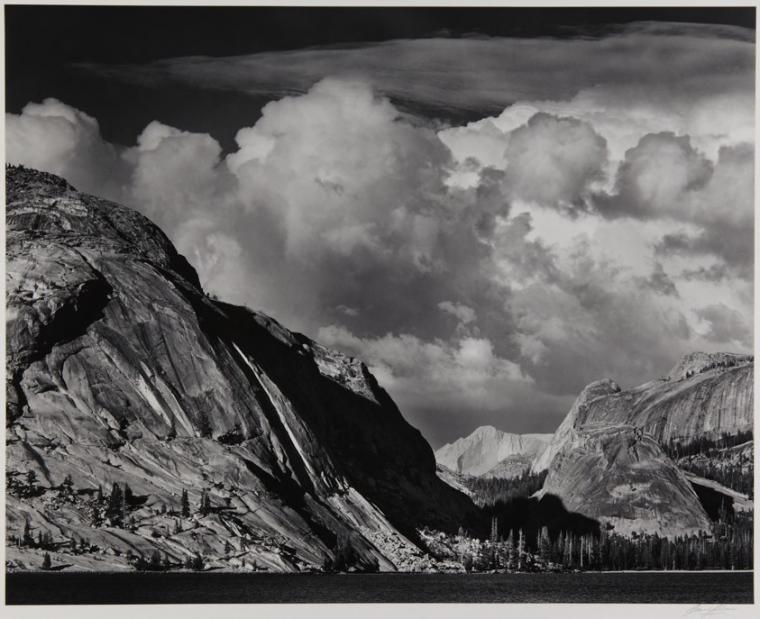
Ansel Adams, American 1902 - 1984, Tenaya Lake, Mount Coness, Yosemite National Park, 1946, Gelatin silver print, 15 x1/4 x 19 ½ inches, Figge Art Museum, City of Davenport Art Collection, Gift of Mrs. Wilson Shorey in memory of her husband, Wilson Shorey
Through Sunday, August 27
Figge Art Museum, 225 West Second Street, Davenport IA
An exhibit of arresting works by arguably the most famous and influential American landscape photographer of the 20th century, Ansel Adams, the Sierra Club, & the Making of a Landscape Icon will be on display at Davenport's Figge Art Museum through August 27, the exhibition showcasing a spectacular suite of 16 images from the artist's Portfolio Three: Yosemite Valley.
“Portfolio Three: Yosemite Valley captures the timeless beauty and grandeur of Yosemite, as seen through the lens of Ansel Adams," said Figge Executive Director and CEO Michelle Hargrave. "This exhibition highlights his meticulous composition and masterful use of light and demonstrates the profound impact Adams had on photography and conservation. As we celebrate his remarkable contributions, we hope that his artistic vision, craftsmanship, and deep reverence for the natural world will encourage visitors to contemplate, appreciate, and protect the sacred landscapes that inspire our souls.”
At the age of 26, Adams (1902-1984) served as the Sierra Club’s official trip photographer. Founded by John Muir, the Scottish American naturalist and environmental philosopher, the Sierra Club’s initial mission was the preservation and conservation of California's Sierra Nevada, a mountain range located primarily in eastern central California. In his first role with the Club, Adams accompanied large groups of members on month long excursions in Yosemite – the Club’s home – and in the surrounding Sierra Nevadas. First published in the Sierra Club Bulletin, his impressive images captured and promoted the natural beauty found in Yosemite. Portfolios of Adams’s images were produced in several editions and sold to promote the Club’s conservation efforts.
After the first photographs and paintings of Yosemite were made in the late 1840s, word of the valley’s beauty spread more widely. In 1861, Carleton Watkins, aided by his mammoth-plate view camera, created impressive large-format photographs of Yosemite astonishing viewers on the East Coast. Watkins’ images helped persuade the U.S. Government to establish, in 1890, Yosemite as the third National Park, after Yellowstone and Sequoia. Adams added to Watkins’ legacy by making a body of breathtaking images, both intimate and grand, that inspired the preservation of some of the country’s most beautiful and fragile lands.
Of course, turning Yosemite into a National Park was not without its costs. In the mid-19th century, state-backed militias forcibly removed the Southern Sierra Miwok peoples from the area – including the Ahwahnee for whom the valley floor had been home for a millennium – to exploit Yosemite’s natural resources. And for the past century, the rapid increase in visitors to over three million annually has taxed the park’s resources, threatening the very beauty they have come to see. In response, the Sierra Club and members of the Mono Lake Paiute and Shoshone communities are taking the lead by proposing alternatives to the National Park Service’s solution of paving paradise further. In this effort, photographs by Adams, as well as those by several new generations of photographers, serve as reminders of Yosemite’s iconic beauty and the perils it continues to face.
“The distinguishing factor in Adams work was his intimate familiarity with his subject," said Figge Director of Collections and Exhibitions Andrew Wallace. "The countless hours he spent hiking and photographing the valley and surrounding peaks gave him invaluable perspective not only on Yosemite, but on the natural environment more broadly, His strong connection to the area made his photographs uniquely iconic and provided a reminder of why such landscapes need to be protected.”
With Eddie Brian and Caroline Pasierb the exhibit's supporting sponsors, the Quad Cities Regional Business Journal its media sponsor, and contributing sponsors including Hunt and Diane Harris, Sears Seating, Carolyn Levine, and the Leonard Kallio Trust, Ansel Adams, the Sierra Club, & the Making of a Landscape Icon will be on display through August 27, with regular museum hours 10 a.m. to 5 p.m. on Tuesdays through Saturdays (10 a.m. to 9 p.m. on Thursdays) and noon to 5 p.m. on Sundays. Museum admission is $4-10, and more information is available by calling (563)326-7804 and visiting FiggeArtMuseum.org.










